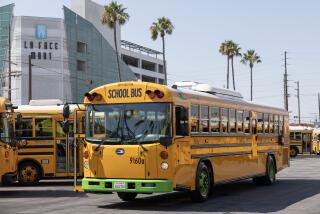Year-Round Operation for L.A. Schools Voted : Board Schedules 1987 Phasing In of Program; Called ‘Only Option’ for Overcrowded District
After four months of reviewing its options--and rejecting most of them as unworkable--the Los Angeles school board voted 5 to 2 Monday to begin phasing in a year-round operation in 1987.
No board member expressed enthusiasm about switching to a year-round school schedule, but those who voted for it said it was needed as a last resort.
The Los Angeles Unified School District, already overcrowded with 579,000 students, expects to gain 82,000 more children in the next five years.
The year-round schedule is “the only option that is likely to assure a classroom for every student in the district,” said Westside board member Alan Gershman, a statement echoed by the four other members.
In Effect in Some Schools
Currently, nearly a quarter of the district’s students attend classes on a year-round schedule. Last September, Supt. Harry Handler proposed that the schedule be gradually adopted systemwide.
But under Monday’s vote, no new schools will switch to year-round operation this fall for the 1986-87 school year.
Instead, the district will purchase about 200 portable classroom bungalows, loosen the integration formulas in about 50 schools and bus an additional 16,000 students away from the most crowded neighborhoods.
By the following year, however, the board said it will probably put 19 more schools on an all-year session. Though no schools were named Monday--and none will be selected until December--district officials said the new year-round schools will be those closest to the city’s most crowded neighborhoods.
This year, 93 of the district’s 618 schools operate on a year-round schedule, under which about one-fourth of each school’s students and teachers are on vacation at any given time. Most of these schools are southeast or west of downtown Los Angeles and in the east San Fernando Valley.
Though the board decided to vote only on plans for two years ahead, officials say they expect most schools to move to the year-round schedule by the early 1990s.
The most distant and least crowded schools--those in west San Fernando Valley and in West Los Angeles--will be the last to reach their capacity with the traditional September-to-June schedule.
In recent votes on the overcrowding issue, the school board members have undergone a political reversal from two years ago. Then, the liberal members representing the inner-city neighborhoods--Rita Walters from South-Central Los Angeles, Jackie Goldberg from Hollywood and Wilshire Corridor area and Larry Gonzalez from the Eastside--had opposed year-round schools, calling them an unfair burden placed on minority children. Meanwhile, the San Fernando Valley members, including Roberta Weintraub, had favored the idea as a way to cut down on long-distance busing of students from inner-city neighborhoods.
But on Monday, both Weintraub and David Armor from the West Valley voted against more year-round schools, saying the idea was decidedly unpopular among their constituents.
“This is a dark period for the district,” said Armor, who predicts that the year-round program could prove as unpopular with parents as did mandatory busing in the late 1970s.
Alternatives Proposed
Armor favored enlarging the classes as a way to fit in more students, an option that garnered no support among the board. He also voted--alone--in favor of a “staggered day” schedule for high school students. Under this plan, school would be in session from 7 a.m. to 5:30 p.m. with students coming and going at different times.
This schedule “is a proven disaster,” said Gonzalez, recounting testimony from teachers, principals and students who used the extended-day schedule at Huntington Park High School in 1980.
The plan approved for 1987-88 also assumes that the district will reopen three closed schools in the West Valley and purchase even more portable classrooms.
The cost of coping with the overcrowding will grow steadily. This year, the school district is busing about 33,000 students away from overcrowded areas, at a cost of more than $30 million. By the fall of 1987 even with the bungalows and more year-round operations, the district expects to have to bus 36,000 more students, at an estimated extra cost of $36 million a year.
Lottery Revenues
Gonzalez, noting the soaring revenues from the state lottery, offered the one encouraging note of Monday’s meeting.
The district received $30 million as its share from the first three months of the lottery. By what he called a conservative estimate, the school system would accumulate $290 million in three years for building new schools. An elementary school costs about $10 million, he noted, and 16 are now on the drawing boards.
But the one catch is the language of the lottery initiative. It specifically bars “construction” and requires that all the money be spent for “instructional purposes.”
The Los Angeles district is pushing a bill in the Legislature that would change the initiative to allow it to spend the money for building new schools.
More to Read
Sign up for Essential California
The most important California stories and recommendations in your inbox every morning.
You may occasionally receive promotional content from the Los Angeles Times.











